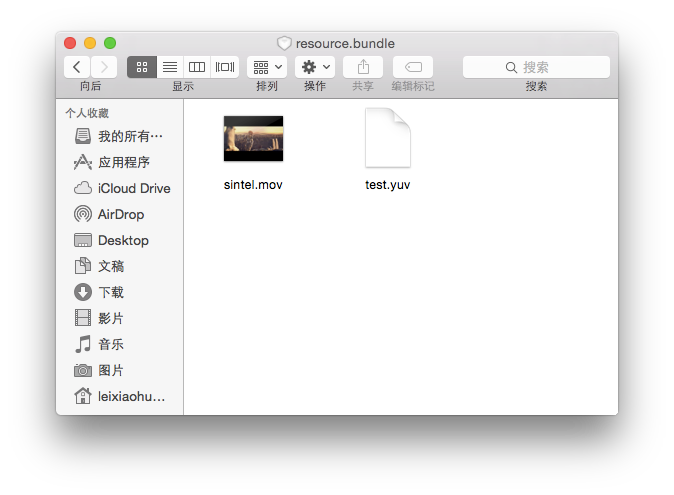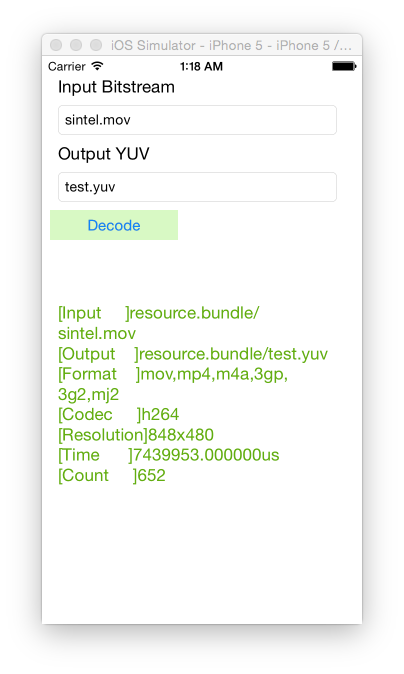=====================================================
最简单的基于FFmpeg的移动端例子系列文章列表:
最简单的基于FFmpeg的移动端例子:Android HelloWorld
最简单的基于FFmpeg的移动端例子:Android 视频解码器
最简单的基于FFmpeg的移动端例子:Android 视频解码器-单个库版
最简单的基于FFmpeg的移动端例子:Android 推流器
最简单的基于FFmpeg的移动端例子:Android 视频转码器
最简单的基于FFmpeg的移动端例子附件:Android 自带播放器
最简单的基于FFmpeg的移动端例子附件:SDL Android HelloWorld
最简单的基于FFmpeg的移动端例子:IOS HelloWorld
最简单的基于FFmpeg的移动端例子:Windows Phone HelloWorld
=====================================================
本文记录IOS平台下基于FFmpeg的视频解码器。该示例C语言的源代码来自于《最简单的基于FFMPEG+SDL的视频播放器》。相关的概念就不再重复记录了。
源代码
项目的目录结构如图所示。
/**
* 最简单的基于FFmpeg的视频解码器-IOS
* Simplest FFmpeg IOS Decoder
*
* 雷霄骅 Lei Xiaohua
* leixiaohua1020@126.com
* 中国传媒大学/数字电视技术
* Communication University of China / Digital TV Technology
* http://blog.csdn.net/leixiaohua1020
*
* 本程序是IOS平台下最简单的基于FFmpeg的视频解码器。
* 它可以将输入的视频数据解码成YUV像素数据。
*
* This software is the simplest decoder based on FFmpeg in IOS.
* It can decode video stream to raw YUV data.
*
*/
#import "ViewController.h"
#include <libavcodec/avcodec.h>
#include <libavformat/avformat.h>
#include <libavutil/imgutils.h>
#include <libswscale/swscale.h>
@interface ViewController ()
@end
@implementation ViewController
- (void)viewDidLoad {
[super viewDidLoad];
// Do any additional setup after loading the view, typically from a nib.
}
- (void)didReceiveMemoryWarning {
[super didReceiveMemoryWarning];
// Dispose of any resources that can be recreated.
}
- (IBAction)clickDecodeButton:(id)sender {
AVFormatContext *pFormatCtx;
int i, videoindex;
AVCodecContext *pCodecCtx;
AVCodec *pCodec;
AVFrame *pFrame,*pFrameYUV;
uint8_t *out_buffer;
AVPacket *packet;
int y_size;
int ret, got_picture;
struct SwsContext *img_convert_ctx;
FILE *fp_yuv;
int frame_cnt;
clock_t time_start, time_finish;
double time_duration = 0.0;
char input_str_full[500]={0};
char output_str_full[500]={0};
char info[1000]={0};
NSString *input_str= [NSString stringWithFormat:@"resource.bundle/%@",self.inputurl.text];
NSString *output_str= [NSString stringWithFormat:@"resource.bundle/%@",self.outputurl.text];
NSString *input_nsstr=[[[NSBundle mainBundle]resourcePath] stringByAppendingPathComponent:input_str];
NSString *output_nsstr=[[[NSBundle mainBundle]resourcePath] stringByAppendingPathComponent:output_str];
sprintf(input_str_full,"%s",[input_nsstr UTF8String]);
sprintf(output_str_full,"%s",[output_nsstr UTF8String]);
printf("Input Path:%s\n",input_str_full);
printf("Output Path:%s\n",output_str_full);
av_register_all();
avformat_network_init();
pFormatCtx = avformat_alloc_context();
if(avformat_open_input(&pFormatCtx,input_str_full,NULL,NULL)!=0){
printf("Couldn't open input stream.\n");
return ;
}
if(avformat_find_stream_info(pFormatCtx,NULL)<0){
printf("Couldn't find stream information.\n");
return;
}
videoindex=-1;
for(i=0; i<pFormatCtx->nb_streams; i++)
if(pFormatCtx->streams[i]->codec->codec_type==AVMEDIA_TYPE_VIDEO){
videoindex=i;
break;
}
if(videoindex==-1){
printf("Couldn't find a video stream.\n");
return;
}
pCodecCtx=pFormatCtx->streams[videoindex]->codec;
pCodec=avcodec_find_decoder(pCodecCtx->codec_id);
if(pCodec==NULL){
printf("Couldn't find Codec.\n");
return;
}
if(avcodec_open2(pCodecCtx, pCodec,NULL)<0){
printf("Couldn't open codec.\n");
return;
}
pFrame=av_frame_alloc();
pFrameYUV=av_frame_alloc();
out_buffer=(unsigned char *)av_malloc(av_image_get_buffer_size(AV_PIX_FMT_YUV420P, pCodecCtx->width, pCodecCtx->height,1));
av_image_fill_arrays(pFrameYUV->data, pFrameYUV->linesize,out_buffer,
AV_PIX_FMT_YUV420P,pCodecCtx->width, pCodecCtx->height,1);
packet=(AVPacket *)av_malloc(sizeof(AVPacket));
img_convert_ctx = sws_getContext(pCodecCtx->width, pCodecCtx->height, pCodecCtx->pix_fmt,
pCodecCtx->width, pCodecCtx->height, AV_PIX_FMT_YUV420P, SWS_BICUBIC, NULL, NULL, NULL);
sprintf(info, "[Input ]%s\n", [input_str UTF8String]);
sprintf(info, "%s[Output ]%s\n",info,[output_str UTF8String]);
sprintf(info, "%s[Format ]%s\n",info, pFormatCtx->iformat->name);
sprintf(info, "%s[Codec ]%s\n",info, pCodecCtx->codec->name);
sprintf(info, "%s[Resolution]%dx%d\n",info, pCodecCtx->width,pCodecCtx->height);
fp_yuv=fopen(output_str_full,"wb+");
if(fp_yuv==NULL){
printf("Cannot open output file.\n");
return;
}
frame_cnt=0;
time_start = clock();
while(av_read_frame(pFormatCtx, packet)>=0){
if(packet->stream_index==videoindex){
ret = avcodec_decode_video2(pCodecCtx, pFrame, &got_picture, packet);
if(ret < 0){
printf("Decode Error.\n");
return;
}
if(got_picture){
sws_scale(img_convert_ctx, (const uint8_t* const*)pFrame->data, pFrame->linesize, 0, pCodecCtx->height,
pFrameYUV->data, pFrameYUV->linesize);
y_size=pCodecCtx->width*pCodecCtx->height;
fwrite(pFrameYUV->data[0],1,y_size,fp_yuv); //Y
fwrite(pFrameYUV->data[1],1,y_size/4,fp_yuv); //U
fwrite(pFrameYUV->data[2],1,y_size/4,fp_yuv); //V
//Output info
char pictype_str[10]={0};
switch(pFrame->pict_type){
case AV_PICTURE_TYPE_I:sprintf(pictype_str,"I");break;
case AV_PICTURE_TYPE_P:sprintf(pictype_str,"P");break;
case AV_PICTURE_TYPE_B:sprintf(pictype_str,"B");break;
default:sprintf(pictype_str,"Other");break;
}
printf("Frame Index: %5d. Type:%s\n",frame_cnt,pictype_str);
frame_cnt++;
}
}
av_free_packet(packet);
}
//flush decoder
//FIX: Flush Frames remained in Codec
while (1) {
ret = avcodec_decode_video2(pCodecCtx, pFrame, &got_picture, packet);
if (ret < 0)
break;
if (!got_picture)
break;
sws_scale(img_convert_ctx, (const uint8_t* const*)pFrame->data, pFrame->linesize, 0, pCodecCtx->height,
pFrameYUV->data, pFrameYUV->linesize);
int y_size=pCodecCtx->width*pCodecCtx->height;
fwrite(pFrameYUV->data[0],1,y_size,fp_yuv); //Y
fwrite(pFrameYUV->data[1],1,y_size/4,fp_yuv); //U
fwrite(pFrameYUV->data[2],1,y_size/4,fp_yuv); //V
//Output info
char pictype_str[10]={0};
switch(pFrame->pict_type){
case AV_PICTURE_TYPE_I:sprintf(pictype_str,"I");break;
case AV_PICTURE_TYPE_P:sprintf(pictype_str,"P");break;
case AV_PICTURE_TYPE_B:sprintf(pictype_str,"B");break;
default:sprintf(pictype_str,"Other");break;
}
printf("Frame Index: %5d. Type:%s\n",frame_cnt,pictype_str);
frame_cnt++;
}
time_finish = clock();
time_duration=(double)(time_finish - time_start);
sprintf(info, "%s[Time ]%fus\n",info,time_duration);
sprintf(info, "%s[Count ]%d\n",info,frame_cnt);
sws_freeContext(img_convert_ctx);
fclose(fp_yuv);
av_frame_free(&pFrameYUV);
av_frame_free(&pFrame);
avcodec_close(pCodecCtx);
avformat_close_input(&pFormatCtx);
NSString * info_ns = [NSString stringWithFormat:@"%s", info];
self.infomation.text=info_ns;
}
@end
运行结果
App在手机上运行后的结果如下图所示。单击“Decode”,将会把位于resource.bundle中的“sintel.mov”文件解码为“sintel.yuv”文件并存储于相同的目录下。

下载
simplest ffmpeg mobile
项目主页
Github:https://github.com/leixiaohua1020/simplest_ffmpeg_mobile
开源中国:https://git.oschina.net/leixiaohua1020/simplest_ffmpeg_mobile
SourceForge:https://sourceforge.net/projects/simplestffmpegmobile/
CSDN工程下载地址:http://download.csdn.net/detail/leixiaohua1020/8924391
[Android]
simplest_android_player: 基于安卓接口的视频播放器
simplest_ffmpeg_android_helloworld: 安卓平台下基于FFmpeg的HelloWorld程序
simplest_ffmpeg_android_decoder: 安卓平台下最简单的基于FFmpeg的视频解码器
simplest_ffmpeg_android_decoder_onelib: 安卓平台下最简单的基于FFmpeg的视频解码器-单库版
simplest_ffmpeg_android_streamer: 安卓平台下最简单的基于FFmpeg的推流器
simplest_ffmpeg_android_transcoder: 安卓平台下移植的FFmpeg命令行工具
simplest_sdl_android_helloworld: 移植SDL到安卓平台的最简单程序
[IOS]
simplest_ios_player: 基于IOS接口的视频播放器
simplest_ffmpeg_ios_helloworld: IOS平台下基于FFmpeg的HelloWorld程序
simplest_ffmpeg_ios_decoder: IOS平台下最简单的基于FFmpeg的视频解码器
simplest_ffmpeg_ios_streamer: IOS平台下最简单的基于FFmpeg的推流器
simplest_ffmpeg_ios_transcoder: IOS平台下移植的ffmpeg.c命令行工具
simplest_sdl_ios_helloworld: 移植SDL到IOS平台的最简单程序




























 3929
3929

 被折叠的 条评论
为什么被折叠?
被折叠的 条评论
为什么被折叠?








